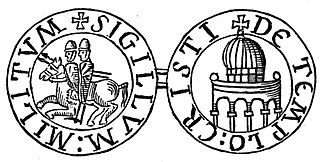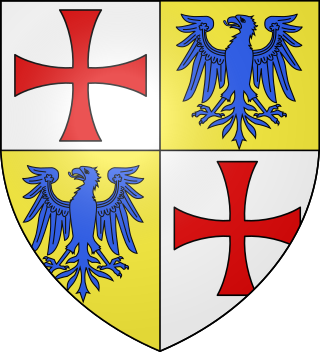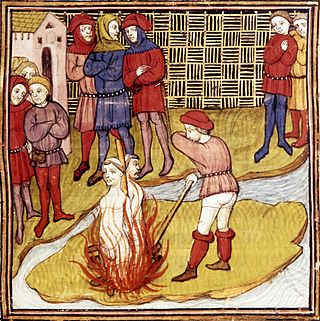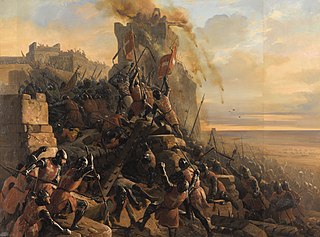
The Poor Fellow-Soldiers of Christ and of the Temple of Solomon, mainly known as the Knights Templar, was a military order of the Catholic faith, and one of the wealthiest and most popular military orders in Western Christianity. They were founded c. 1119, headquartered on the Temple Mount in Jerusalem, and existed for nearly two centuries during the Middle Ages.

Jacques de Molay, also spelled "Molai", was the 23rd and last grand master of the Knights Templar, leading the order sometime before 20 April 1292 until it was dissolved by order of Pope Clement V in 1312. Though little is known of his actual life and deeds except for his last years as Grand Master, he is one of the best known Templars.

The Kingdom of Cyprus was a medieval kingdom of the Crusader states that existed between 1192 and 1489. Initially ruled as an independent Christian kingdom, it was established by the French House of Lusignan after the Third Crusade. It comprised not only the entire island of Cyprus, but it also had a foothold on the Anatolian mainland: Antalya between 1361 and 1373, and Corycus between 1361 and 1448.

Robert IV de Sablé was Lord of Sablé, the eleventh Grand Master of the Knights Templar from 1191 to 1192 and Lord of Cyprus from 1191 to 1192. He was known as the Grand Master of the Knights Templars and the Grand Master of the Holy and Valiant Order of Knights Templars.
The Grand Masters of the Knights Templar during the later 12th and the 13th century used a double-sided seal which showed a representation of The Dome of the Rock on one side, and the Order's symbol of two knights on one horse on the other side. This design is first attested as in use by Bertrand de Blanquefort, the order's sixth Grand Master, in 1158, forty years after its foundation, and it remained in use until the dissolution of the order in 1312.

Guillaume de Sonnac was Grand Master of the Knights Templar from 1247 to 1250.

Gilbert Horal or Erail was the 12th Grand Master of the Knights Templar from 1193 to 1200.

Armand de Lavoie (or Hermann de Lavoie was a descendant of the Counts of Périgord and a Grand Master of the Knights Templar.

The Poor Fellow-Soldiers of Christ and the Temple of Jerusalem, or Templars, was a military order founded in 1119/20.

The Knights Templar, full name The United Religious, Military and Masonic Orders of the Temple and of St John of Jerusalem, Palestine, Rhodes and Malta, is a fraternal order affiliated with Freemasonry. Unlike the initial degrees conferred in a regular Masonic Lodge, which only require a belief in a Supreme Being regardless of religious affiliation, the Knights Templar is one of several additional Masonic Orders in which membership is open only to Freemasons who profess a belief in Christianity. One of the obligations entrants to the order are required to declare is to protect and defend the Christian faith. The word "United" in its full title indicates that more than one historical tradition and more than one actual order are jointly controlled within this system. The individual orders 'united' within this system are principally the Knights of the Temple, the Knights of Malta, the Knights of St Paul, and only within the York Rite, the Knights of the Red Cross.

The Order of Knights of the Hospital of Saint John of Jerusalem, commonly known as the Knights Hospitaller, was a medieval and early modern Catholic military order. It was founded in the Kingdom of Jerusalem in the 12th century and had headquarters there until 1291, thereafter being based in Kolossi Castle in Cyprus (1302–1310), the island of Rhodes (1310–1522), Malta (1530–1798), and Saint Petersburg (1799–1801).

Thibaud Gaudin was the Grand Master of the Knights Templar from August 1291 until his death in April 1292.

Assassin's Creed: Bloodlines is a 2009 action-adventure video game developed by Griptonite Games and published by Ubisoft. It is the second spin-off installment in the Assassin's Creed franchise, and acts as a direct sequel to Assassin's Creed (2007). Beginning shortly after that game's events, Bloodlines follows Altaïr Ibn-LaʼAhad as he travels to Cyprus to eliminate the last remnants of the Templar Order and learn more about their plans. The game also explores Altaïr's relationship with Maria Thorpe, a Templar agent whose life he spared in the first game and who would eventually become his wife.

Ardfinnan Castle, is the sister castle of Lismore Castle and was built circa 1185 to guard the river crossing at Ardfinnan in County Tipperary, Ireland. It is situated on the River Suir, seven miles west of Clonmel. The castle is currently privately owned and is not open for public viewing.

The fall of Ruad in 1302 was one of the culminating events of the Crusades in the Eastern Mediterranean. When the garrison on the tiny Isle of Ruad fell, it marked the loss of the last Crusader outpost on the coast of the Levant. In 1291, the Crusaders had lost their main power base at the coastal city of Acre, and the Muslim Mamluks had been systematically destroying any remaining Crusader ports and fortresses since then, forcing the Crusaders to relocate their dwindling Kingdom of Jerusalem to the island of Cyprus. In 1299–1300, the Cypriots sought to retake the Syrian port city of Tortosa, by setting up a staging area on Ruad, two miles (3 km) off the coast of Tortosa. The plans were to coordinate an offensive between the forces of the Crusaders, and those of the Ilkhanate. However, though the Crusaders successfully established a bridgehead on the island, the Mongols did not arrive, and the Crusaders were forced to withdraw the bulk of their forces to Cyprus. The Knights Templar set up a permanent garrison on the island in 1300, but the Mamluks besieged and captured Ruad in 1302. With the loss of the island, the Crusaders lost their last foothold in the Holy Land. Attempts at other Crusades continued for centuries, but the Europeans were never again able to occupy any territory in the Holy Land until the 20th century, during the events of World War I.

The Hospitaller conquest of Rhodes took place in 1306–1310. The Knights Hospitaller, led by Grand Master Foulques de Villaret, landed on the island in summer 1306 and quickly conquered most of it except for the city of Rhodes, which remained in Byzantine hands. Emperor Andronikos II Palaiologos sent reinforcements, which allowed the city to repel the initial Hospitaller attacks, and persevere until it was captured on 15 August 1310. The Hospitallers transferred their base to the island, which became the centre of their activities until it was conquered by the Ottoman Empire in 1522.
Jean de Ronay was knight of the Order of Saint John of Jerusalem who was appointed Grand Commander of the Knights Hospitaller by the Grand Master Guillaume de Chateauneuf in 1243 or 1244. He served as interim Grand Master of the Knights Hospitaller from 1244 to 1250 during the captivity of de Chateauneuf. He died in battle during the Seventh Crusade.

The fall of Outremer describes the history of the Kingdom of Jerusalem from the end of the last European Crusade to the Holy Land in 1272 until the final loss in 1302. The kingdom was the center of Outremer—the four Crusader states—formed after the First Crusade in 1099 and reached its peak in 1187. The loss of Jerusalem in that year began the century-long decline. The years 1272–1302 are fraught with many conflicts throughout the Levant as well as the Mediterranean and Western European regions, and many Crusades were proposed to free the Holy Land from Mamluk control. The major players fighting the Muslims included the kings of England and France, the kingdoms of Cyprus and Sicily, the three Military Orders and Mongol Ilkhanate. Traditionally, the end of Western European presence in the Holy Land is identified as their defeat at the Siege of Acre in 1291, but the Christian forces managed to hold on to the small island fortress of Ruad until 1302.

The history of the Knights Hospitaller in the Levant is concerned with the early years of the Order of the Hospital of St. John of Jerusalem, the Knights Hospitaller, through 1309. The Order was formed in the later part of the eleventh century and played a major role in the Kingdom of Jerusalem, in particular, the Crusades. This lasted until the West was expelled from the Holy Land, with the Order conquering Rhodes in the early fourteenth century. Among the most important internal events of the early years of the kingdom were the foundation of the Military Orders, which included the Hospitallers, the Knights Templar and the Teutonic Order. Unlike the Hospitallers' beginnings as a benevolent organization, the Templars and Teutonic knights began with a military mission. These three major Orders would play a major role in the military activities of the kingdom, sometimes cooperatively, sometimes not. On the battlefield they frequently shared among them the most important tactical roles, the vanguard and rear-guard.

















